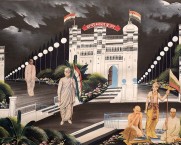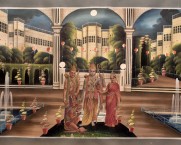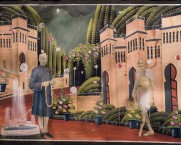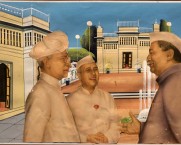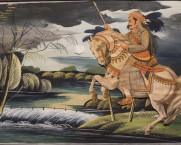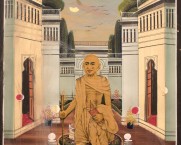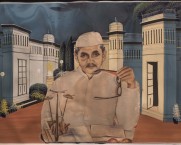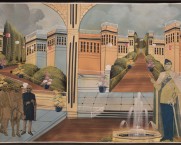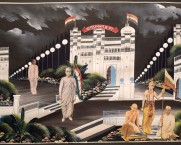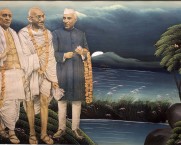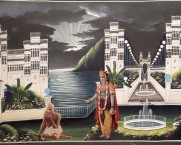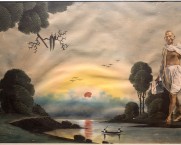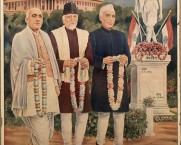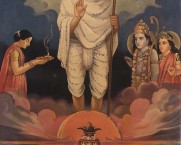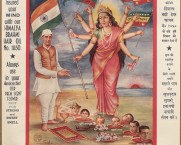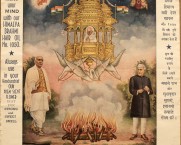C&L Shows
What Freedom Looks Like
2018
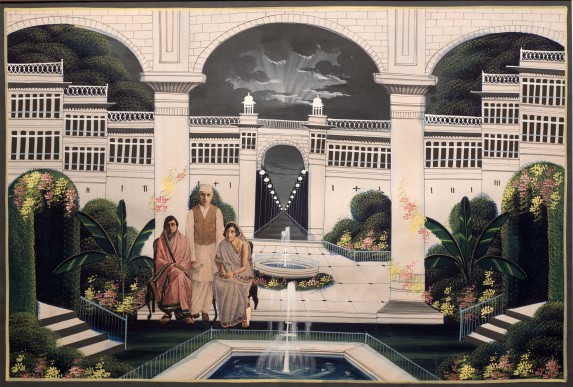
Overview
Researched and curated by Aditya Ruia
Shekhavati, north of Jaipur, was home to Marwari families who were staunch supporters of India’s freedom movement. It is also the find spot of the collages included in the current exhibition. The works in What Freedom Looks Like perform the role of broadsides¹, “topical broadsheets and visual images”². They disseminate the cause of nation building within local spaces and spheres. It is likely that these collages were executed locally in Shekhavati, usingbackgrounds painted by women artists³ in Nathdwara, or in urban areas where the owners of havelis lived. The prints seem to have come from diverse sources across India. The painted backgrounds follow two broad themes: the urban and the rural. They follow a formulaic pattern presenting a notion of an ideal nation.
By the mid 1940’s it was evident that the British could not continue to hold its colonies and dismemberment was imminent. These collages map this cusp. They illustrate the intensity of the final moments prior to independence
as well as the experiments of a young nation, achieved through a long and mediated process involving numerous groups, leaders, shifting alliances and machinations.
Ramrajya
The Indian National Congress, established in 1885 in Bombay, was founded to lobby for greater economic reforms and a larger role in the making of British policy. As part of an attempt to bring about national awareness, Tilak started promoting the idea of self-rule through the metaphor of Ramrajya (the ideal rule of Rama as expounded in the Ramayana). The artist M.V. Dhurandhar famously painted Ramrajya abhishekh and this image also found mass circulation in the form of lithographs from the Ravi Varma Press. Ramrajya became synonymous of ideal kingship and remained so in the popular consciousness of the subcontinent.
Bharat Mata
Bharata was the first Chakravartin after whom the land of the Mahabharata came to be named as Bharatavarsha (India). The geography of India has witnessed ever-changing boundaries.
Bharat Mata, as we understand her in these collages, is fundamentally a novel, even unorthodox, goddess. In order to shape her iconography, artists interpreted writings by various national leaders such as Tagore, Subramania Bharati and others. The resulting images, borrowed from the immemorial past, rooted her in the present. Cartographically, she has been represented as having her head and hair in the Himalayas, her arms in the East and West, and her feet in the South.
Abanindranath Tagore depicted and presented Bengal as Banga Mata in his much published eponymous painting. This icon depicted a saintly woman in a style sari holding in her hands a sheet of cloth, a sheaf of rice, manuscript
pages and a rosary, signifying industry, agriculture, learning and religious belief. In the avatar represented in these collages, she appears in the shantabhava (benign mood). Her body is visualized as bearing snow capped mountains, gushing streams, waterfalls, dams, verdant grasslands and lakes, “an aesthetic characterized as patriotic pastrol7.”
Political context The story of Indian independence is one that evolved over a period of a century. In these broadsides, the prominent players are Mahatma Gandhi (1869 -1948), Vallabhbhai Patel (1875 – 1950), Jawaharlal Nehru (1889 – 1964), and Subas Chandra Bose (1897 -1945). Indisputably the most revered and famous of her sons was Mahatma Gandhi, acknowledged as ‘Father of the Nation’. Gandhi implemented through the party structure a unique form of agitation known as Satyagraha8 (satya = truth; agraha = convince without being obstinate or uncompromising). This outlook came in conflict with Subas Chandra Bose, Bhagat Singh and other hardliners who were part of the freedom movement. In fact, Bose resigned as President of the Congress, after the Tripuri congress of the AICC (All India Congress Committee). This marked the beginning of the diverging paths the two leaders were to take in the service of Bharat Mata. Informed by contemporary narratives, these collages document the anxieties around the founding of a nation. They are entirely successful in producing documents for later generations that illustrate the momentous changes taking place at that time in the Indian subcontinent.

